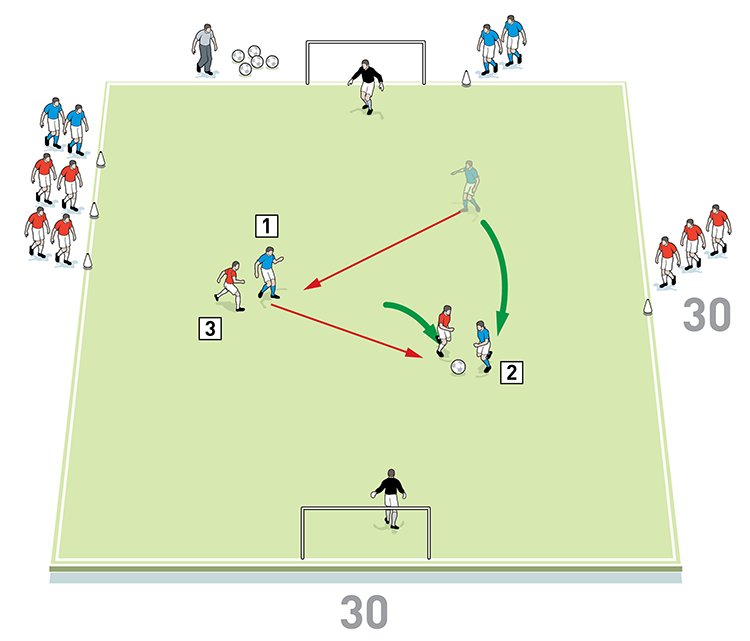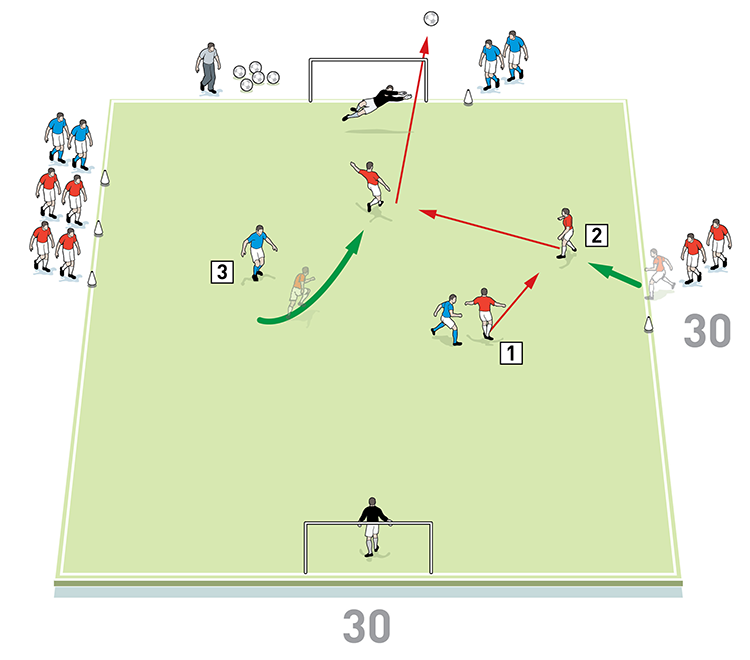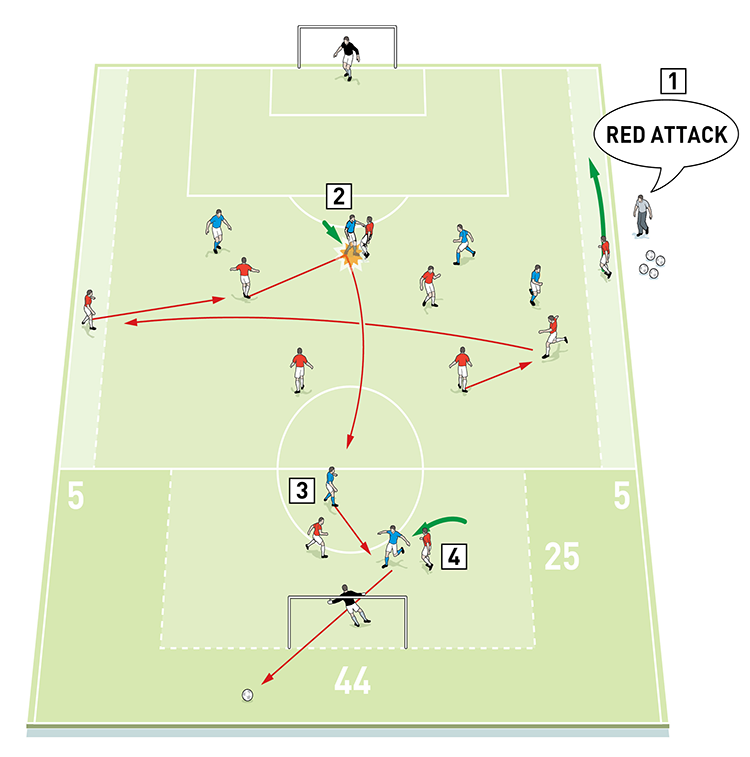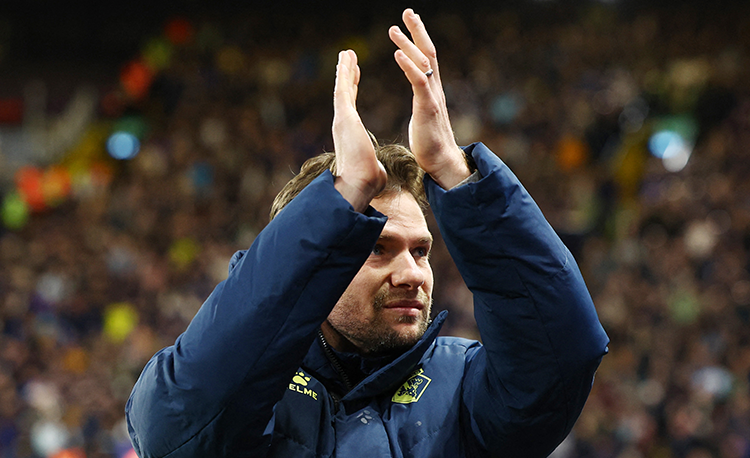You are viewing 1 of your 1 free articles
Attacking and defending transitions
This session is about attacking and defending transitions, focusing on the key moments when the ball changes hands. We work on how we can defend and exploit these most exciting and important phases of the game, either by building a fast attack with the support of the full backs or by playing the ball early to the forwards.
| Area | Up to full pitch |
| Equipment | Balls, bibs, cones, 2 full size goals |
| No. of Players | Up to 20 players + 2 goalkeepers |
| Session Time |
Transition – 2v2 into 3v2: 15mins, Attacking waves: 20mins, Transition 11v11 game: 20mins |
This session is about attacking and defending transitions, focusing on the key moments when the ball changes hands. We work on how we can defend and exploit these most exciting and important phases of the game, either by building a fast attack with the support of the full backs or by playing the ball early to the forwards.
We practise this type of session because the league we play in is quite physical and has a good mixture of playing styles, with a high number of turnovers and restarts.
This session has high physical demands and requires intensity and a strong mentality to make it a success.
We believe in challenging the players throughout the session and we provide feedback in the rest periods and discuss problems and solutions that are occurring within the practices as we progress.
We also demonstrate to the players, and discuss with them, their roles and responsibilities and the importance of being in control in these situations.
We tend to adjust the numbers and set-ups used in the session based on the style of our future opponents but it is always linked to the basic principles of how we play.
What do I get the players to do?
Transition – 2v2 into 3v2
We set up an area of 30x30 yards, with a goal and a goalkeeper at each end. We’re using 15 outfield players, divided into a defending team of nine and an attacking team of six. In the diagram, the reds are the defenders and the blues are the attackers. Three attackers and six defenders start on one touchline, three defenders start on the opposite touchline, and three more attackers start next to the goal.
Play starts with the coach serving to the first attacker at the side of the pitch. The attacker passes across the pitch to a team mate, who runs from beside the goal to receive. Two defenders follow the pass, one tracking the first attacker and the other closing down the second attacker, as shown [1a].
1a

2. The second blue attacker runs onto the pitch from beside the goal and receives
3. Two red defenders follow the ball, one to track the first blue attacker and one to close down the second blue attacker
It’s now 2v2, as the blue attackers try to score and the red defenders attempt to stop them, as shown [1b].
1b

2. The blues must keep possession and try to create the opportunity to score in the bottom goal
3. The red defenders press the attackers and try to win possession
If the defending pair wins the ball, they are joined by a team mate from the other side to help them attack, making it a 3v2 in favour of the counter-attacking defenders, as shown [1c].
1c

2. When the defenders win the ball, a team mate from the opposite touchline can join the play, giving the reds a 3v2 overload while counter-attacking
3. The blues must make the quick transition to defending and try to regain the ball
If the ball goes dead, all restarts are from the coach. The next players in each queue then take their turns to play.
What do I get the players to do next?
Attacking waves
We set up on two thirds of a full pitch as shown, with a goal and a goalkeeper at each end. We mark out a five-yard channel on each flank and a 25x44-yard box in front of the goal that’s over the halfway line.
We’re using 16 outfield players split into an attacking team of 10 (the reds) and a defending team of six (the blues). Six red attackers and four blue defenders start in the main area in a 6v4. The red attacking team also have full backs starting at the bottom end of each wide channel, plus two more players in the box over the halfway line acting as defenders for the attacking team. They are pitted in a 2v2 with two blues who are the strikers for the defending team.
Plays starts with a pass from the coach to the red attacking team in the main area. The attackers play the ball quickly from side to side, as shown [2a], until the coach signals that they can attack the top goal in a 6v4. The red full backs can join the attack, supporting play from the wide channels and giving the attackers an 8v4 overload.
2a

2. It’s 6v4 in the main area and the reds pass the ball from side to side until the coach calls for them to attack
3. The reds have full backs who support play from the wide channels, making the attack 8v4
4. The blues are defending the top goal
5. The blue defending team has two strikers in the small box at the bottom, who anticipate the forward pass on transition
If the blue defending team wins possession, the red attacking team must immediately try to win it back or recover into a good position for the transition, while the blues must look for a quality forward pass to their strikers, as shown [2b]. The blues then try to score in the bottom goal, going 2v2 against the reds in the box. If the reds win the ball back in the 2v2, they can launch an attack from the back.
2b

2. If the blue defending team wins possession, they play long to their strikers in the small box over the halfway line
3. The blue strikers can attack the goal in a 2v2 against the reds
4. The keeper and the red defenders can quickly feed their attackers at the other end if they win the ball
If the ball goes out of play, the coach should quickly play a second ball into the main area for the attacking team.
How would you put this into a game situation?
Transition 11v11 game
We set up for the game between the penalty areas of a full size pitch, with a goal and a goalkeeper at each end. The width of the playing area is coned off five yards in from each touchline and an offside line is marked at each end.
We’re using 20 outfield players split into two teams of ten. Each team has two midfielders and four forwards in their attacking half of the pitch and four defenders in the defending half.
The coach starts by playing the ball into one of the teams, who then attack the opposing defenders in a 6v4. If the defenders win possession, they can look to exploit the spaces, on turnover, into their attackers, with full backs joining in to support, as shown [3].
3

2. If the defenders win the ball, they can play early to their forwards in the other half of the pitch
3. A full back joins in to support the attack
4. Defenders should use the offside line to squeeze play
5. If the goalkeeper gathers the ball, he can launch an attack via his full back. But if the ball goes out of play, restarts are from the coach
The defenders in the other half should use the offside line to squeeze play. If the goalkeeper collects the ball, he can feed his full backs, who can then play to the forwards.
If the ball goes out of play, restarts are from the coach – this will keep the tempo high.
We can progress this game by having the midfielders play against each other, making it 6v6 in each half. Full backs can join the attack on both sides, giving the attacking team an 8v6 overload.
What are the key things to look out for?
When attacking we want to see that players are changing tempo, showing good 1v1 skills and using movement to either lose a defender or draw defenders out of position.
We want to see players showing that they can shield the ball in order to protect their possession.
Players should also demonstrate that they can work together to affect the defending unit, and use unselfish movement to create and exploit space between the lines and in behind. Above all, to score goals players should be unpredictable and show that they can play with imagination and flair.
When defending, we want players to use the correct body shape and good footwork when approaching the attackers, making blocking movements and checking runs.
When in transition from attack to defence, we want to see players showing that they can recover and rebuild the defensive unit, effectively managing the space in front and in behind.
What are the typical mistakes players might make and how do I avoid them?
Sometimes players are not aware of what’s around them. Also, they can fail to secure possession on turnover and look to break early.
Another typical mistake is that players may start to react to what’s happening rather than anticipating the play in advance.
To avoid these mistakes, we use rest periods and breaks in the session to introduce key messages to the players on an individual basis.
Related Files
Editor's Picks
Deep runs in the final third
Using the goalkeeper in build-up play
Pressing principles
Intensive boxes drill with goals
Penetrating the final third
Creating and finishing
My philosophy
Pressing initiation
Compact team movement
Coaches' Testimonials

Alan Pardew

Arsène Wenger

Brendan Rodgers

Carlos Carvalhal

José Mourinho

Jürgen Klopp

Pep Guardiola

Roy Hodgson

Sir Alex Ferguson

Steven Gerrard
Coaches' Testimonials

Gerald Kearney, Downtown Las Vegas Soccer Club

Paul Butler, Florida, USA

Rick Shields, Springboro, USA

Tony Green, Pierrefonds Titans, Quebec, Canada
Join the world's leading coaches and managers and discover for yourself one of the best kept secrets in coaching. No other training tool on the planet is written or read by the calibre of names you’ll find in Elite Soccer.
In a recent survey 92% of subscribers said Elite Soccer makes them more confident, 89% said it makes them a more effective coach and 91% said it makes them more inspired.
Get Monthly Inspiration
All the latest techniques and approaches
Since 2010 Elite Soccer has given subscribers exclusive insight into the training ground practices of the world’s best coaches. Published in partnership with the League Managers Association we have unparalleled access to the leading lights in the English leagues, as well as a host of international managers.
Elite Soccer exclusively features sessions written by the coaches themselves. There are no observed sessions and no sessions “in the style of”, just first-hand advice delivered direct to you from the coach.









